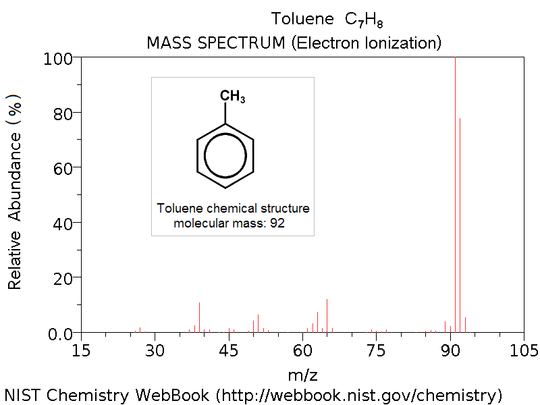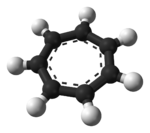
Tropylium ion
Encyclopedia
In organic chemistry
, the tropylium ion is an aromatic species with a formula of [C7H7]+. Its name derives from the molecule tropine
(itself named for the molecule atropine
). Salts of the tropylium cation can be stable, e.g. tropylium tetrafluoroborate
. It can be made from cycloheptatriene
(tropylidene) and bromine
or phosphorus pentachloride
It is a heptagonal, planar, cyclic ion; as well, it has 6 π-electrons (4n+ 2, where n=1), which fulfills Hückel's rule
of aromaticity. It can coordinate as a ligand
to metal
atoms.
The structure shown is a composite of seven resonance contributors in which each carbon carries part of the positive charge.
In 1891 G. Merling obtained a water soluble salt from a reaction of cycloheptatriene
and bromine
. The structure was elucidated by von Eggers Doering
and Knox in 1954
in the form of a signal at m/z = 91 and is used in mass spectrum analysis
. This fragment is often found for aromatic compounds containing a benzyl unit. Upon ionization
, the benzyl fragment is cleaved off as a cation (PhCH2+), which rearranges to the highly stable tropylium cation (C7H7+).

Organic chemistry
Organic chemistry is a subdiscipline within chemistry involving the scientific study of the structure, properties, composition, reactions, and preparation of carbon-based compounds, hydrocarbons, and their derivatives...
, the tropylium ion is an aromatic species with a formula of [C7H7]+. Its name derives from the molecule tropine
Tropine
Tropine is a derivative of tropane containing a hydroxyl group at third carbon. It is also called 3-tropanol.Benzatropine and etybenzatropine are derivatives of tropine. It is also a building block of atropine, a cholinergic drug prototypical of the muscarinic antagonist class.-External Links:*...
(itself named for the molecule atropine
Atropine
Atropine is a naturally occurring tropane alkaloid extracted from deadly nightshade , Jimson weed , mandrake and other plants of the family Solanaceae. It is a secondary metabolite of these plants and serves as a drug with a wide variety of effects...
). Salts of the tropylium cation can be stable, e.g. tropylium tetrafluoroborate
Tropylium tetrafluoroborate
Tropylium tetrafluoroborate is an organic compound containing the tropylium cation and the non-coordinating tetrafluoroborate counteranion. It is a stable salt which is commercially available....
. It can be made from cycloheptatriene
Cycloheptatriene
Cycloheptatriene is an organic compound with the formula C7H8. This colourless liquid has been of recurring theoretical interest in organic chemistry. It is a ligand in organometallic chemistry and as a building block in organic synthesis...
(tropylidene) and bromine
Bromine
Bromine ") is a chemical element with the symbol Br, an atomic number of 35, and an atomic mass of 79.904. It is in the halogen element group. The element was isolated independently by two chemists, Carl Jacob Löwig and Antoine Jerome Balard, in 1825–1826...
or phosphorus pentachloride
It is a heptagonal, planar, cyclic ion; as well, it has 6 π-electrons (4n+ 2, where n=1), which fulfills Hückel's rule
Hückel's rule
In organic chemistry, Hückel's rule estimates whether a planar ring molecule will have aromatic properties. The quantum mechanical basis for its formulation was first worked out by physical chemist Erich Hückel in 1931...
of aromaticity. It can coordinate as a ligand
Ligand
In coordination chemistry, a ligand is an ion or molecule that binds to a central metal atom to form a coordination complex. The bonding between metal and ligand generally involves formal donation of one or more of the ligand's electron pairs. The nature of metal-ligand bonding can range from...
to metal
Metal
A metal , is an element, compound, or alloy that is a good conductor of both electricity and heat. Metals are usually malleable and shiny, that is they reflect most of incident light...
atoms.
 |
 |
 |
Skeletal formula The skeletal formula of an organic compound is a shorthand representation of its molecular structure, developed by the organic chemist, Friedrich August Kekulé von Stradonitz. Skeletal formulae are ubiquitous in organic chemistry, because they are relatively quick and simple to draw. Carbon and... |
Ball-and-stick model In chemistry, the ball-and-stick model is a molecular model of a chemical substance which is to display both the three-dimensional position of the atoms and the bonds between them... |
Space-filling model In chemistry a space-filling model, also known as calotte model, is a type of three-dimensional molecular model where the atoms are represented by spheres whose radii are proportional to the radii of the atoms and whose center-to-center distances are proportional to the distances between the atomic... |
The structure shown is a composite of seven resonance contributors in which each carbon carries part of the positive charge.
In 1891 G. Merling obtained a water soluble salt from a reaction of cycloheptatriene
Cycloheptatriene
Cycloheptatriene is an organic compound with the formula C7H8. This colourless liquid has been of recurring theoretical interest in organic chemistry. It is a ligand in organometallic chemistry and as a building block in organic synthesis...
and bromine
Bromine
Bromine ") is a chemical element with the symbol Br, an atomic number of 35, and an atomic mass of 79.904. It is in the halogen element group. The element was isolated independently by two chemists, Carl Jacob Löwig and Antoine Jerome Balard, in 1825–1826...
. The structure was elucidated by von Eggers Doering
William von Eggers Doering
William von Eggers Doering was a Professor Emeritus at Harvard University and the former Chair of its Chemistry Department...
and Knox in 1954
Mass spectrometry
The tropylium ion is frequently encountered in mass spectrometryMass spectrometry
Mass spectrometry is an analytical technique that measures the mass-to-charge ratio of charged particles.It is used for determining masses of particles, for determining the elemental composition of a sample or molecule, and for elucidating the chemical structures of molecules, such as peptides and...
in the form of a signal at m/z = 91 and is used in mass spectrum analysis
Mass spectrum analysis
Mass-spectrum analysis is an integral part of mass spectrometry. Organic chemists obtain mass spectra of chemical compounds as part of structure elucidation and the analysis is part of every organic chemistry curriculum.-Basic peaks:...
. This fragment is often found for aromatic compounds containing a benzyl unit. Upon ionization
Electron ionization
Electron ionization is an ionization method in which energetic electrons interact with gas phase atoms or molecules to produce ions...
, the benzyl fragment is cleaved off as a cation (PhCH2+), which rearranges to the highly stable tropylium cation (C7H7+).


